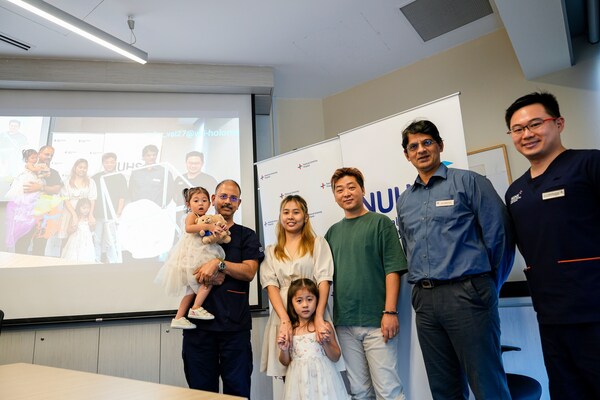 |
Innovative mixed reality technology enhances pre-surgical planning at NUH’s specialised paediatric organ transplant centre in Singapore
SINGAPORE, June 5, 2024 /PRNewswire/ — For the last three decades, the transplant team at the National University Hospital (NUH)‘s Department of Paediatric Surgery in the Khoo Teck Puat – National University Children’s Medical Institute (KTP-NUCMI) and the National University Centre for Organ Transplantation (NUCOT) has journeyed with countless paediatric warriors who have bravely overcome various challenges on their road to recovery.

Avira Han (left) with her family and her team of doctors from the National University Hospital. (Credit: National University Health System)
One remarkable child is little Avira, who at two years old, has already undergone two major life-saving surgeries.
Diagnosed with a rare illness known as biliary atresia when she was less than a month old, bile was trapped inside Avira’s liver, which led to liver damage and scarring. If left untreated, her liver would eventually fail.
Biliary atresia occurs in approximately one in every 20,000 live births, with a slightly higher prevalence in females.
Overcoming the first hurdle with primary treatment
Liver transplantation has proven highly successful in the long-term treatment of children with biliary atresia, with an overall survival of more than 90 per cent. However, the initial treatment is to perform a Kasai procedure because 50 to 60 per cent of children experience significant improvement and may survive well with their own liver until much older.
Hence, Avira first underwent the Kasai procedure at two months old, where her surgeon Adjunct Associate Professor Vidyadhar Mali, a Senior Consultant in the Department of Paediatric Surgery at KTP-NUCMI, NUH, and the Surgical Director of the Paediatric Kidney and Liver Transplantation Programmes at NUCOT, removed the obstructed bile ducts outside the liver and attached a loop of the small intestine directly to the liver, restoring bile flow.
Nonetheless, three in five children may still face progressive liver-related complications following a Kasai procedure.
For Avira, a post-operative follow-up two months later revealed progressive deterioration of her liver function and a liver transplant was deemed necessary. Her mother, Mrs Han, stepped forward as a donor.
Preparing for a complex, high-risk surgery with hybrid mixed reality technology
Preparing Avira for her transplant required overcoming significant challenges.
Liver transplants in a small child (weighing less than 10kg) is relatively rare and considered highly challenging. These cases require specialised surgical expertise and careful planning due to the complexities involved in such small patients.
Factors such as the child’s small size, the need for appropriately sized liver donor grafts, and the delicate nature of paediatric patients add significant risks and technical difficulty to the procedure.
Being extremely small, Avira needed to be on a feeding tube to gain weight in two months. Furthermore, her small size meant that her surgeons would have to split her mother’s donated liver (known as graft reduction) to ensure that the organ would be a right fit for Avira.
Unlike adults, small children being transplanted with grafts too large or too small for them may present issues following liver transplantation and as the child grows older.
Studies have found that different approaches and graft-size matching strategies that are age- and body weight-appropriate are crucial for better outcomes in paediatric living donor liver transplantations.
In addition to reducing the graft size of the donor liver, the surgical team needed to determine the exact size of the liver graft needed. Incorrectly estimating the size of the graft could lead to a longer time on the operating table for Avira, and could also increase the risk of graft damage.
To ensure the right size of the graft for Avira, the surgical team, led by Adj A/Prof Mali, employed a hybrid technique of utilising mixed reality imaging (“holomedicine”) to compare the child’s CT scan and the CT scan of the donor liver. This played an important role in accurate pre-operative estimation of the mother’s liver size into Avira’s body.
“Holomedicine leverages mixed reality to interact with virtual objects superimposed onto the real world, allowing for unparalleled accuracy in pre-surgical planning,” explained Dr Gao Yujia, Consultant, Division of Hepatobiliary & Pancreatic Surgery, Department of Surgery, NUH, and the Assistant Group Chief Technology Officer leading the holomedicine programme at the National University Health System (NUHS).
“This hybrid technique enhances surgical planning, giving us a solid road map with the potential of greater precision so that patient care and safety can be improved during the surgery itself,” said Adj A/Prof Mali.
Little Avira’s transplant surgery – which took place in July 2022 – was a success, with both mother and child making a full recovery. Today, Avira is much like other children her age, a playful and energetic toddler, with a bright future ahead.
NUCOT is the only specialist centre in Singapore which has both adult and paediatric liver and kidney transplantation services under one roof, bringing together a comprehensive multidisciplinary suite of medical specialty services required throughout our patients’ transplantation journeys.
As we celebrate World Transplant Day, we honour the courage of all transplanted children and their families. Through continuous innovation and compassionate care, NUCOT remains committed to transforming lives and offering hope to families navigating the complexities of organ transplantation.
View original content to download multimedia: Read More